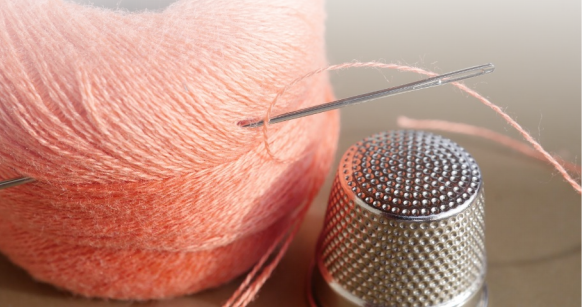We all know what a thimble is – I’m sure that like me you’ve been familiar with them forever! I remember playing with my own grandma’s battered and worn thimble when I was allowed to “sort out” her button box. Thimbles can also be decorative, collectible items, but here I’m more concerned with their use as a sewing tool.

A thimble may be defined as “a small cap, usually of metal, worn to protect the finger when pushing a needle through cloth in sewing” though today thimbles are made from a wide variety of materials, including rubber, leather, and elastic. You can even purchase an adhesive disk instead if you don’t like the feel of a traditional thimble. Normally, you wear your thimble on the middle finger of the hand you use to push the needle through the fabric. If you prefer to use another finger instead, then simply move the thimble to that finger. The thimble will then protect your finger from the eye end of your needle when you push it through the fabric. Some stitchers also like to wear a rubber thimble on their index finger to help them grasp the needle more firmly.
The word “thimble” itself is thought to come from the old English word thymel, meaning thumbstall. Thimbles have been around for a very long time – in excavations near Moscow bones were found that were used 30000 years ago by mammoth hunters to stitch pearl embroideries onto pieces of leather. The Romans popularised the use of bronze thimbles throughout their empire and around 1150 a thimble is mentioned as part of a noble lady’s dowry upon her entry into a convent.
To learn to use a thimble successfully it’s really important to find one that fits and suits you. There are lots of different sizes and types! This is a very personal decision which may take a little trial and error.
Choose a thimble that is not too tight and not too loose. To test for a good fit, try a thimble on the middle finger of your sewing hand. Hang your hand down at your side and move your fingers around. If it stays on and doesn’t feel too tight, then it’s a definite possibility! Wear it around and go about doing other things for 15 minutes or so. If you’ve found the one that’s right for you then your thimble should stay on and feel comfortable enough that you can nearly forget you’re wearing it!
If you’ve got any hints/tips for using a thimble please let us know in the comments below!
*Article taken from the November issue of Bustle & Sew Magazine. Find out more HERE.
The last metal thimble I purchased via the internet was just a tad too big and not returnable. So I cut a small piece of sticky on one side ‘moleskin’ (sold here in the states in the pharmacy section of stores) and stuck it inside my thimble, just one one side, now the thimble not only fits but my nail is cushioned against the soft moleskin. Do a Google search for ‘moleskin for blisters’ to find it.
That’s a great idea, thanks so much for sharing xx